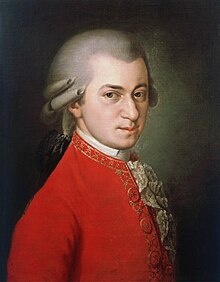Symphony No. 8 (Mozart)

The Symphony No. 8 in
K. 48), by Wolfgang Amadeus Mozart is dated December 13, 1768.[1] Mozart wrote the symphony in Vienna, when he was twelve years old, at a time when he and his family were already due to have returned home to Salzburg. In a letter to his friend in Salzburg, Lorenz Hagenauer, Leopold Mozart says of the delay that "we could not bring our affairs to a conclusion earlier, even though I endeavored strenuously to do so."[1] The autograph of the Symphony No. 8 is today preserved in the Staatsbibliothek Preusischer Kulturbesitz in Berlin.[2]
Structure
The symphony is in four
French horns, two trumpets, timpani and strings. The inclusion of trumpets and timpani is unusual for Mozart's early symphonies. It has been described as a "ceremonial work".[3]
There are four movements:
- Allegro, 3
4 - Andante, 2
4 G major - Menuetto and Trio, Allegro, 3
4 - Allegrissimo, 12
8
The first movement begins with downward leaps on the
.The second movement is for strings alone and begins with a narrow melodic range which expands toward the end.
The third movement is a Minuet full of rapid string passages, and includes the trumpets and timpani, but not during the Trio.
The final movement is a gigue, whose main theme unusually does not end the movement.
References
Sources
- ISBN 1-933648-23-6
- ISBN 0-19-816286-3
External links
- Symphony in D K. 48: Score and critical report (in German) in the Neue Mozart-Ausgabe
- Free scores by Symphony No. 8 at the International Music Score Library Project (IMSLP)

